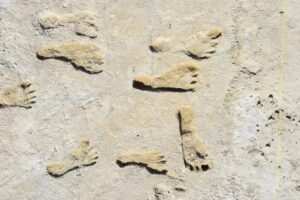The arrival of humans on the American continent is an issue that intrigues the scientific community for decades, but has no answers yet. Some Artifacts 13 thousand years ago and traces were what archaeologists had to work. However, a set of footprints in the North America It turned out to be older than we thought.
New research published in Science Advances demonstrated that some of these footprints found in New Mexico, United Stateshave more than 20 thousand years. The tracks were found in the White Sands National Parkan old layer of sediment that once was a river. After the waters dried, the erosion of the wind accumulated plaster in the dunes that define the area today.
The search for the age of these traces began in 2021, when researchers from the United Kingdom dated seeds and polens of that same place and found that they had between 23 and 21 thousand years.
However, other scientists contested the discovery. The criticism said that these plant remains were absorbing old water, prior to the sediment layer, and would be more recent than thought.
New dating confirms age
In search of a new dating, Professor Vance Holliday, the main author of the research, went to White Sands with his team in 2022. He was surprised to find that some of the beds with human footprints are Red sedimentsand it was possible to make the calculations to estimate the age of these tracks.
This reddish stratum is trapped between the white, green and black layers made of plaster, clays and mud. Its composition is of material brought from close mountains by the wind.
The research, completed in 2025, revealed: the red sediment has between 22,400 and 20,700 yearswhich confirms the previous estimates. The study featured two groups of scientists and three different laboratories to dating with 55 sample radiocarbon. All came to similar conclusions.
“It’s a remarkably consistent record. You get to a point where it’s really difficult to explain all this. As I say in the article, it would be a serendipity (the act of discovering pleasant things by chance) extremely having all these dates giving you a consistent image that is wrong,” Holliday said in a one communication.
Read more:
The oldest people in America?
With the confirmation of the age of tracks, the current challenge of researchers is to explain the existence of humans in the Americas before Clovis culture – The set of artifacts that, until then, believed to be the first hominids to reach the American continent. According to Holliday, the footprints are 10,000 years older than clovis traces.
“It’s a strange feeling when you go out and look at the footprints and see them in person. You realize that they basically contradict everything they taught you about the settlement of North America,” said Jason Windingstad, co -author of the research.
The researchers speculate that these hominids would have been extinct after they arrived in North America. Thus, it would only be in Clovis culture that the adaptation of humans to the American environment would have occurred.
However, more research is needed to understand who these mysterious ancestral hominids were. For now, after getting an answer, researchers will have to deal with new questions.











